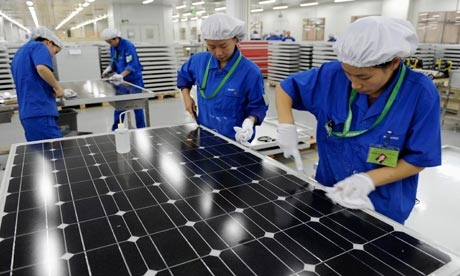Bad news is emerging from China’s solar sector.
It looks like LDK Solar Ltd. (NYSE: LDK) has failed to repay all of some $23.8 million in dollar-denominated bonds that matured April 15. This is of concern, since LDK also needs to repay a loan that’s ten times bigger than that by June.
Could we be heading for the second Chinese solar-sector failure so far this year?
 Rival company Suntech Power Holdings Co. Ltd. (NYSE: STP) also defaulted in its bonds recently. LDK shares closed at $1.12 on Monday in New York and are trading around $1.09 today. The company stated that it has reached a partial payment settlement with two bond holders owning around $16.5 million of that debt.
Rival company Suntech Power Holdings Co. Ltd. (NYSE: STP) also defaulted in its bonds recently. LDK shares closed at $1.12 on Monday in New York and are trading around $1.09 today. The company stated that it has reached a partial payment settlement with two bond holders owning around $16.5 million of that debt.
LDK reported dismal Q4 results today, with a loss of $517 million. Back in December, the company had $2.5 billion in debt, due to mature over the next 12-18 months. Some $500 million is due over the next two quarters.
Adding to its woes, the U.S. duties on Chinese solar products means the company must deal with countervailing duties of 15.24 percent, as well as anti-dumping duties of 25.96 percent on all its solar panels and cells sold in the U.S. Worse, Europe is considering similar sanctions on solar imports from China.
A Faltering Chinese Solar Sector
It isn’t just LDK that’s in trouble. As mentioned earlier, Suntech is also facing dismal financial difficulties.
Add to the list Trina Solar Ltd. (NYSE: TSL) and JA Solar Holdings Co. Ltd. (NASDAQ: JASO), both of which have stated that they won’t be able to make good on the payments for their U.S. bonds set to mature over the coming months ($123 million in convertible bonds for JA Solar in May, and $83.5 million in senior notes for Trina Solar in July).
Suntech’s situation is actually quite a bit worse, as Reuters reports that several of the company’s lenders pushed the company’s primary manufacturing unit to declared bankruptcy. The company Suntech defaulted on $541 million in bonds.
Could Chinese state subsidies be to blame for this apparent systemic failure that’s developing in that nation’s solar sector? Between 2008 and 2011, state lenders showered solar companies with credit, leading to a sharp decline in the cost of solar panels over 2012 when demand began to slow. This decline was as much as 17 percent, according to Bloomberg.
Now, with the losses accruing, companies are rapidly proving unable to pay back these loans (which could total in excess of $1.7 billion).
All of this sounds quite familiar to the experiences of U.S. solar companies in the recent past. Remember the ill-fated Solyndra? China has remained firm in its support for the solar sector while U.S. and European counterparts have gone into restructuring agreements or even declared bankruptcy.
However, in a clear sign that even the Chinese government recognizes the need for change, the State Council declared last December that it would cease funding solar panel makers who prove unprofitable. Instead, the Council would push for consolidation.
Local governments would be restricted from overtly supporting companies that are clearly struggling, thus allowing some degree of market logic to determine final outcomes for such companies.
Worldwide, solar demand continues to grow. However, there isn’t a great amount of parity between this growth in demand and growth in manufacturing capacity, which means solar panel manufacturers have been writing down investments. Especially in the U.S. and in Europe, clean energy subsidies and other government initiatives have taken a hit due to the protracted economic downturn.
Our analysts have traveled the world over, dedicated to finding the best and most profitable investments in the global energy markets. All you have to do to join our Energy and Capital investment community is sign up for the daily newsletter below.
Solar Installations Remain a Hot Sector
Solar installation companies like SolarCity (NASDAQ: SCTY) have been thriving even as panel manufacturers are facing the heat. The leasing model SolarCity provides, which allows a customer to lease a system with precious little money down but also gain savings in electricity and power usage via solar technology, has proven a hit.
Leasing companies like SolarCity and peers SunRun and Sungevity attend to the materials, panels, installation, and setup and maintenance. Just last year, solar leasing comprised more than 60 percent of all residential installations in California, which already leads the solar market in the U.S.
SolarCity has grown from $32.4 million (2010) to $59.5 million (2011), despite showing a net loss of $73.7 million over 2011. And last year, the Department of Defense signed off on a deal with SolarCity for $1 billion to fund 300 MW in installations for military residences.
Solar installations, then, appear to be where the interest lies right now, while the solar manufacturing market fumbles around trying to stabilize itself.
If you liked this article, you may also enjoy:


